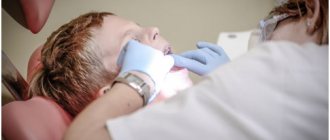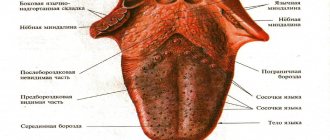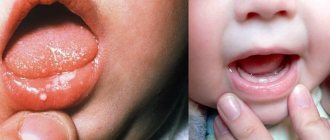Have questions?
Herpetic or herpes stomatitis is an inflammation of the oral mucosa caused by the herpes simplex virus. The disease manifests itself as ulcers in the mouth, headache and even fever.
This type of stomatitis accounts for about 80% of all infectious lesions of the oral cavity. The infection mainly develops in children's bodies, and children under three years of age are most susceptible to it. HIV carriers, diabetics, patients with chronic pathologies and people with weakened immune systems are also at risk.
Clinical manifestations
Symptoms of herpetic stomatitis vary depending on the form and stage of progression of the disease. Common signs of a viral infection include:
- swelling of the cervical and submandibular lymph nodes;
- jump in body temperature;
- blisters on the mucous membrane of the cheeks, tongue, palate, which are damaged and turn into bleeding ulcers and erosive formations;
- discomfort, pain, burning, itching in the mouth;
- weakness, migraine.
In adults, viral herpetic stomatitis is more complicated. At the same time, a severe form of the disease often develops in people who had an acute stage of the disease in childhood, and at the moment their body is weakened due to severe hypothermia, blood disease, cancer, etc.
What is stomatitis
Stomatitis can be either an independent disease, which includes several varieties, or a symptom of another, more serious pathology. All stomatitis is characterized by inflammation of the oral mucosa. This is a fairly common problem that can occur repeatedly and in some cases be transmitted from the sick person to other people. There are no tests for the presence of stomatitis; the doctor determines this diagnosis based on examination data and the patient’s complaints. A smear can be taken afterwards to determine the causative agent of the disease. Having made conclusions, the specialist will give recommendations on how to treat stomatitis.
Classification of the disease
Before starting treatment for herpes stomatitis, it is necessary to determine the form and degree of its progression. At the same time, acute herpetic stomatitis in children is diagnosed already when the virus first enters the body.
The severity of the disease is divided into:
- Light. Small blisters form on the oral mucosa - they quickly disappear after they rupture;
- Average. The rashes are more extensive, body temperature rises (up to 38º);
- Heavy. The patient has an abundance of ulcers in his mouth, and after they disappear, new ones appear. Symptoms are supplemented by fever, headache and chills, sometimes the patient feels sick and has diarrhea.
In the absence of proper treatment, chronic recurrent herpetic stomatitis develops. This form of the disease is already characterized by group rashes (on the inside of the cheeks, tongue and palate). The formations combine and form painful erosions. In the recurrent stage, except for rashes, no other symptoms of the disease are noted. The disease may return 2-6 months after treatment.
Herpes stomatitis in children is a serious illness that requires immediate medical attention.
You probably know that more than 90% (and according to some sources, all 98%) of the population of our planet are carriers of the herpes virus. Most people live their lives and have no idea about it; for some, the presence of herpes manifests itself only as watery, quickly passing ulcers on the lips during a cold.
But for some, this harmful virus can bring a lot of trouble - genital herpes, herpes zoster, postherpetic neuralgia and herpes stomatitis, which also happens in children. Children under 3 years of age are more likely to get sick, and acute herpetic stomatitis in children . This is a rather serious disease that requires immediate medical intervention, as it has a complex course and is accompanied by a high fever - up to 40°, which is dangerous for young children due to possible seizures and other complications.
Manifestation of herpes stomatitis
Parents are interested in how herpes manifests itself in the mouth, how to distinguish it from other inflammatory diseases and how to treat viral stomatitis . The disease begins with a catarrhal period, when bright red spots appear on the gums, inside the cheeks and lips, causing obvious discomfort to the child because they itch and tingle. If older children immediately draw the attention of their parents to this pathology, then the children simply become irritable, whiny, and stop eating. In children, the temperature rises almost immediately, so the onset of herpes stomatitis is often mistaken for a sore throat or acute respiratory viral infection and the moment of starting treatment for stomatitis is missed. A day later, whitish bubbles appear in place of the spots, which burst and turn into ulcers, which are very painful for the baby. At the same time, enlargement of the lymph nodes is often observed, there may be vomiting, dyspeptic symptoms - diarrhea, rumbling in the abdomen.
Treatment of herpes stomatitis
In acute cases of herpes stomatitis, hospitalization of the child is almost always indicated. If the course of the disease is mild and is not accompanied by fever or other complications that can only be determined by a doctor, treatment at home is possible. In this case, the sick child should be isolated as much as possible from other family members so as not to infect them too. If a diagnosis of herpetic stomatitis in children is established, treatment has some features than for other types of stomatitis. Firstly, this is a local treatment - rinsing with antiseptic solutions (to prevent secondary infection of erosions) using a solution of pimafucin, sage or chamomile decoctions. Children over 1 year old can treat their mouths with propolis, which gives very good results.
How to quickly cure stomatitis in a child under 1 year old - in the article “Treatment of stomatitis in infants. In any case, a course of acyclovir (Zovirax) will be prescribed to lubricate the gums and tongue, for older children - in the form of tablets, after which keratoplasty is prescribed - substances that actively restore damaged oral mucosa - vitamin A, sea buckthorn or rosehip oil, Vinylin ointment . So that the baby can eat - before eating, you can lubricate the painful areas with Baby Doctor ointment, Kalgel, etc. as prescribed by the doctor. At the same time, a course of vitamins and immunomodulators is prescribed to improve immunity. If herpes stomatitis is detected on time and appropriate treatment is prescribed, it is completely cured (but the herpes virus remains in the body forever).
How to treat herpetic stomatitis?
Treatment of herpetic stomatitis in children and adults can be general or local. The therapeutic treatment strategy is determined by the form and severity of the disease. In this case, the patient is usually shown:
- high-calorie diet, drinking plenty of fluids, bed rest;
- antiviral drugs (orally, intravenously or intramuscularly);
- restorative therapy (taking vitamins);
- symptomatic treatment (use of antipyretics, painkillers, anti-inflammatory drugs);
- local therapy (rinses, applications, etc.).
When choosing tactics for treating acute or chronic herpetic stomatitis in adults and children, it is important to correctly determine the form and stage of the disease. That is why experts urge patients not to self-medicate, but to immediately consult a doctor if signs of damage appear.
Therapy under the supervision of a specialist will allow you to recover quickly and without consequences for the body. With the right approach, herpes stomatitis in a child or adult can be cured in 10-14 days.
Acute herpetic stomatitis in children and adults: treatment
When herpetic stomatitis is detected in adults and children, it is possible to determine how and how to treat this disease only after differential diagnosis: the herpetic and aphthous types are very similar in symptoms, but the drugs used for therapy are completely different. Therefore, first of all, you need to do tests and make sure that the cause of the disease was the herpes virus.
When treating the disease, antiviral drugs, immunomodulators (to stimulate the immune system), local antiseptic treatments, and vitamin complexes are used to maintain the body's defenses. Additionally, symptomatic medications are used: painkillers, antipyretics for high body temperature in children (above 38.5 degrees).
The doctor prescribes all medications and treatment regimens individually, taking into account the patient’s age, the general condition of his body, the severity of the disease and its form (acute or chronic). In addition, proper dental care is also important - both during and after treatment. The doctor will give all the necessary recommendations for care and help you choose hygiene products individually.
Herpetic stomatitis during pregnancy requires a special approach. In addition to local treatment with antiseptics, it also requires antiviral therapy, but the doctor selects the drugs very carefully, taking into account the possible risks for the pregnant woman and the fetus. Treating yourself in this situation is extremely risky; self-medication can cause serious complications in the body of the mother and her unborn child.
“32 Dent” clinics provide all types of dental services, including gum treatment. Dentists are equipped with the latest equipment, and doctors have extensive experience working with a variety of, even the most complex, clinical cases. By contacting us, you receive high-quality treatment and lasting results at an affordable price.
Sources:
- Personal experience as a dentist;
- Danilevsky N.F., Leontyev V.K., Nesin A.F., Rakhniy Zh.I. Diseases of the oral mucosa. - M.: OJSC "Dentistry", 2001;
- Ivanova E.N. and others. Diseases of the oral mucosa. - Rostov n/d.: Phoenix, 2007;
- Ed. prof. A.L. Mashkilleyson, prof. E.V. Borovsky. Diseases of the mucous membrane of the oral cavity and lips. - M.: MEDpress, 2001;
- Kolesov A.A. Pediatric dentistry. M.: Medicine, 1991;
- Vinogradova T.F., Maksimova O.P., Melnichenko E.M. Periodontal disease and oral mucosa in children. M.: Medicine, 1983;
- Whitley RJ, Roizman B. Herpes Simplex virus Infection // The Lancet. 2001.
Acute and chronic herpetic stomatitis
What is stomatitis? What types of stomatitis are more common?
Stomatitis is the general name for diseases that cause inflammation of the oral mucosa.
Among stomatitis, the most commonly diagnosed varieties are those that have a viral basis. Herpetic stomatitis, which is caused by the herpes simplex virus, is especially common.
Clinically, in the oral cavity, herpes infection manifests itself in two forms: 1) chronic recurrent herpes; 2) acute herpetic gingivostomatitis.
Acute herpetic stomatitis is a disease of viral etiology that occurs in both adults and children. Recently, acute herpetic stomatitis is considered as a manifestation of primary herpetic infection with the herpes simplex virus in the oral cavity. The first elements of damage in acute herpetic stomatitis resemble aphthae, which occur against the background of edematous, hyperemic, inflamed oral mucosa. The disease is contagious for individuals who have not previously been infected with the herpes simplex virus. Stomatitis mainly affects children aged 1 to 3 years and young adults.
The disease begins with complaints of general malaise, with an increase in body temperature to 37-37.5 ° C, enlargement of regional lymph nodes, and hypersalivation is observed. The mucous membrane of the mouth, especially the gingival margin, is swollen and hyperemic. At the same time, vesicles filled with serous fluid appear, which then quickly open and merge into erosions, covered with fibrinous plaque, with a scalloped edge along the periphery. The entire process of aft formation lasts four to five days. In this case, the patient complains of pain when eating, burning, itching. If oral care is insufficient, then catarrhal changes (swelling, hyperemia) can turn into ulcerative ones. With proper care and treatment, the patient recovers by the eighth to tenth day. If the disease progresses, the number of erosive elements does not decrease, but increases, the patient’s general condition worsens, weakness, headache, adynamia are observed, body temperature rises to 39–40 ° C, then this may be due to low reactivity of the body, decreased immunity. The body's reactivity depends on various reasons - hypothermia, flu, infectious diseases, blood diseases, cancer. If the necessary treatment of acute herpetic stomatitis is not carried out, a recurrent form occurs, which is accompanied by regular rashes on the mucous membrane of the cavity of vesicles and aphthae.
In the pathogenesis of the disease there are four periods: prodromal, catarrhal, period of rash, period of extinction of the disease. According to the degree of severity, there are mild, moderate, and severe forms.
With a mild form of the disease, there are no symptoms of intoxication of the body. The lesions appear in the form of two or three small bubbles. Epithelization of the mucous membrane occurs quickly.
The moderate form is accompanied by severe toxicosis. Multiple rashes appear on the oral mucosa.
In the severe form, all the signs of an infectious disease are expressed.
A blood test reveals leukopenia, an increase in band neutrophils; saliva reaction is acidic.
Diagnosis of herpetic stomatitis is a difficult task and is based on the use of special molecular biological, virological, serological, cytological and immunological studies.
Treatment of stomatitis can be difficult due to concomitant infection. It includes the prescription of painkillers (gels with lidocaine, articaine topically on the oral mucosa, orally - ketorolac (ketorol, ketalgin)), antiviral drugs (acyclovir or Zovirax orally and topically as an ointment), anti-inflammatory drugs (cholisal, metrogil gel ) and immunomodulators.
Chronic recurrent herpes manifests itself in the form of single or multiple closely spaced rashes - small blisters on the red border of the lips, mucous membrane of the palate, eyes, genitals, skin of the lips, wings of the nose. Usually the appearance of these lesions is accompanied by a burning sensation. Further, the elements merge and form erosive surfaces, and when eating food, painful sensations from irritants occur. A feature of herpes infection is lifelong carriage of the virus after illness.
E. A. Makovskaya, Candidate of Medical Sciences, Geomed Medical Center, Moscow
Note!
- Herpetic stomatitis, which is caused by the herpes simplex virus, is especially common.
- Acute herpetic stomatitis is a disease of viral etiology that occurs in both adults and children.
- Stomatitis mainly affects children aged 1 to 3 years and young adults.
- In the pathogenesis of the disease there are 4 periods: prodromal, catarrhal, period of rash, period of extinction of the disease. According to the degree of severity, there are mild, moderate, and severe forms.
- Diagnosis of herpetic stomatitis is based on the use of special molecular biological, virological, serological, cytological and immunological studies.
- With proper care and treatment, the patient recovers by 8-10 days.
General symptoms of stomatitis
The main manifestation of stomatitis is inflammation of the mucous membrane, however, depending on the form of the disease, additional different symptoms may occur.
There are 3 main features:
- Hyperemia and redness. Swelling and an unhealthy red color indicate the beginning of a pathological process. immediate treatment at this stage of stomatitis , then small round ulcers may appear in the future. They are usually gray or white, with a red border and film.
- Severe pain and ulcers. At this stage, the surface of the mucous membrane is covered with small ulcers. They can be on the inside of the lips and cheeks and even under the tongue. The patient experiences pain at this time and finds it difficult to eat.
- Fever and headache. The rise in temperature may vary depending on the degree of inflammation. With profuse ulcers, it becomes high, and the headache becomes more pronounced.
Stomatitis should be treated as recommended by your dentist. It is best to consult a specialist at the stage of swelling and redness to prevent further development of inflammation and the appearance of ulcers. However, not everyone pays attention to the first symptoms stomatitis .
Is stomatitis transmitted?
Allergic stomatitis
– one of the most common and intractable types of the disease.
The cause is an allergy, but what exactly is allergy is to be determined first. Allergens can be both food and medicine, as well as materials for dentures installed in the oral cavity. The typical course of stomatitis - the occurrence of painful ulcers - can be further complicated by difficulty breathing and swallowing, typical of allergies. Allergic stomatitis is not transmitted
except through hereditary means.
Viral (herpetic) stomatitis
- another popular type of this disease, especially common in small, close groups of people (schools, kindergartens, work groups, camps).
Its cause is the herpes virus, and its features are erosive spread (others may appear next to one ulcer) and the possibility of severe complications with fever, nausea, vomiting and diarrhea. This is the most contagious variety; in 80% of cases, this stomatitis is transmitted both by airborne droplets and by contact
.
Aphthous stomatitis
– most often occurs in adults, and is associated with weakened immunity.
That is why outbreaks of aphthous stomatitis occur mainly in spring and autumn. It is characterized by the formation of aphthae - small ulcers, both single and occurring in clusters. This stomatitis is not contagious
and cannot be passed on to other people.
Fungal stomatitis (candidomycosis)
– is characteristic of both children (mainly infants) and adults, and mainly women.
It occurs due to Candida fungi, which multiply in the mouth due to weakened immunity or long-term use of antibiotics. It is characterized, in addition to the formation of ulcers, by a white “curdled” coating on the tongue, palate and inner surface of the cheeks. This stomatitis is contagious
: it can be transmitted through direct contact or through household and hygiene items (towel, toothbrush, dishes). A pathogenic fungus can remain in the body for some time and develop in an environment favorable to it.
Nicotine stomatitis
– as the name suggests, occurs in smokers as a result of a long-term addiction to cigarettes.
Tobacco smoke, affecting the oral cavity, actively promotes the growth of bacteria, and also irritates the palate, the tissues become denser, resulting in the formation of numerous ulcers. This type of disease is especially dangerous: although it is not transmitted to other people
, and generally goes unnoticed for a long time, it can develop into oral cancer.










